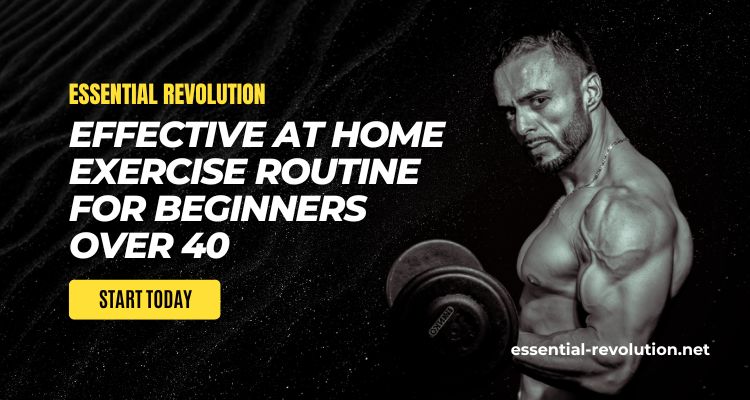Starting an at home exercise routine for beginners can be the key to better health and fitness, especially for men over 40.
Why Exercise is Crucial After 40
As men age, maintaining physical fitness becomes increasingly important. Around the age of 40, muscle mass and bone density begin to decline, metabolism slows down, and the risk of chronic illnesses such as heart disease and diabetes increases. An at home exercise routine for beginners can help counteract these effects, improve overall health, and boost mental well-being.
Benefits of At Home Exercise Routine for Beginners
- Convenience: No need to commute to the gym or adhere to its schedule. Exercising at home allows for flexibility, fitting workouts into your routine as per convenience.
- Cost-Effective: Avoiding expensive gym memberships and specialized equipment can save money.
- Comfort and Privacy: Exercising at home provides a comfortable and private environment, which can be particularly appealing for beginners who may feel self-conscious about their fitness level.
Components of an Effective At Home Exercise Routine for Beginners
To design an effective at home exercise routine for beginners, it’s essential to include a mix of cardiovascular, strength training, as well as flexibility exercises. Here’s a structured plan:
Warm-Up (5-10 minutes)
Warming up is crucial to prepare your body for exercise, reduce the risk of injury, and improve performance.
- March in Place: Lift your knees and swing your arms to get your heart rate up.
- Arm Circles: Extend your arms and make small circles, gradually increasing their size.
- Leg Swings: Hold onto a stable surface and swing one leg forward and backward to loosen your hip joints.
Cardiovascular Exercises (15-20 minutes)
Cardio exercises are essential for improving heart health, burning calories, and boosting overall stamina.
- Jumping Jacks: A classic full-body exercise that increases heart rate.
- High Knees: Stand in place and jog while lifting your knees as high as possible.
- Butt Kicks: Jog in place while kicking your heels up towards your glutes.
- Burpees: A more advanced move, but effective for building cardiovascular endurance and muscle strength.
Strength Training (20-30 minutes)
Strength training helps build muscle, increase metabolism, and strengthen bones. Focus on bodyweight exercises to start.
- Push-Ups: Great for building upper body strength. Modify by doing them on your knees if needed.
- Squats: Excellent for strengthening legs and core. Ensure proper form by keeping knees behind toes.
- Planks: A core exercise that also strengthens your shoulders and back. Start with 20-30 seconds and gradually increase.
- Lunges: Effective for leg strength and balance. Step forward and lower your body until both knees are at 90-degree angles.
- Glute Bridges: Lie on your back with knees bent, lift your hips towards the ceiling to strengthen glutes and lower back.
Flexibility and Cool Down (10-15 minutes)
Flexibility exercises improve range of motion, reduce muscle tension, and aid in recovery.
- Hamstring Stretch: Sit with one leg extended, reach towards your toes, and hold.
- Quadriceps Stretch: Stand on one leg, pull the other foot towards your glutes, and hold.
- Shoulder Stretch: Extend one arm across your body and gently press with the other arm.
- Cat-Cow Stretch: On all fours, alternate between arching your back (cat) and lowering your belly (cow) to stretch your spine.
- Child’s Pose: Sit back on your heels, extend your arms forward, as well as lowering your forehead to the ground for a relaxing stretch.
Tips for Success
- Set Realistic Goals: Start with manageable goals and gradually increase the intensity and duration of your workouts.
- Stay Consistent: Consistency is key. Aim for at least 3-4 workouts per week.
- Listen to Your Body: Pay attention to how your body feels. Rest when needed and avoid overexertion.
- Stay Hydrated and Eat Well: Proper hydration and nutrition support your exercise efforts and overall health.
- Track Your Progress: Keep a journal of your workouts to monitor improvements and stay motivated.
Modifications and Safety
- Modify Exercises as Needed: Don’t hesitate to modify exercises to suit your fitness level. Use chairs for support or perform exercises against a wall if necessary.
- Consult a Professional: If you have any pre-existing health conditions, consult a doctor or a fitness professional before starting any new exercise routine.
- Warm-Up and Cool Down: Always include warm-up and cool-down sessions in your routine to prevent injuries and aid recovery.
Final word about at home exercise routine for beginners
Starting an at home exercise routine for beginners is a powerful step towards better health and fitness, especially for men over 40. So, by incorporating cardiovascular, strength training, and flexibility exercises, you can build a well-rounded routine that suits your needs and lifestyle. Finally, remember to stay consistent, listen to your body, and enjoy the journey towards a healthier, more active life.

